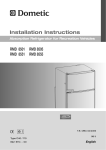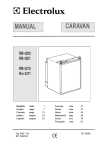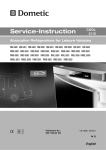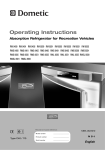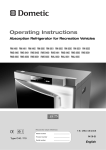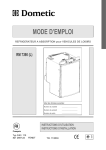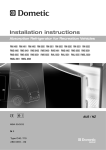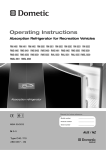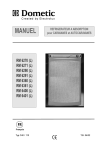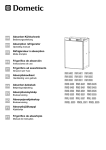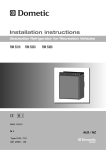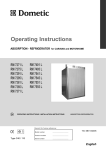Download Dometic RM 8401 Technical data
Transcript
Installation Instructions Absorption Refrigerator for Recreation Vehicles RM RM RM RM RM RM RM RM RM EN 8400 8401 8405 8500 8501 8505 8550 8551 8555 RMS RMS RMS RMS RMS RMS RMS RMS RMS RMS RMS RMS 8400 8401 8405 8460 8461 8465 8500 8501 8505 8550 8551 8555 RML 8550 RML 8551 RML 8555 INSTALLATION INSTRUCTIONS ABSORPTION REFRIGERATOR T.B. MBA 05/2008 Type C40 / 110 N 2-1 English Keep these installation instructions in a safe place. If this device is passed on, please include these installation instructions with it. © Dometic GmbH - 2007 - Subject to change - Printed in Germany 2 Table of contents E1.0 Installation instructions . . . . . . . . . . . . . . . . . . . . . . . . . . . . . . . . . . E1.1 E1.2 E1.3 E1.4 E1.5 E1.6 E1.7 E1.8 E1.9 E1.10 Installation . . . . . . . . . . . . . . . . . . . . . . . . . . . . . . . . . . . . . . . . . . . . . . . . . . . . . . . . . . . . . . . . . Draught-proof installation . . . . . . . . . . . . . . . . . . . . . . . . . . . . . . . . . . . . . . . . . . . . . . . . . . . . . Ventilation and air extraction . . . . . . . . . . . . . . . . . . . . . . . . . . . . . . . . . . . . . . . . . . . . . . . . . . . Installing the ventilation system . . . . . . . . . . . . . . . . . . . . . . . . . . . . . . . . . . . . . . . . . . . . . . . . . Exhaust duct system . . . . . . . . . . . . . . . . . . . . . . . . . . . . . . . . . . . . . . . . . . . . . . . . . . . . . . . . . Installation recess . . . . . . . . . . . . . . . . . . . . . . . . . . . . . . . . . . . . . . . . . . . . . . . . . . . . . . . . . . . . Securing the refrigerator . . . . . . . . . . . . . . . . . . . . . . . . . . . . . . . . . . . . . . . . . . . . . . . . . . . . . . Changing the decor panel . . . . . . . . . . . . . . . . . . . . . . . . . . . . . . . . . . . . . . . . . . . . . . . . . . . . . Gas installation . . . . . . . . . . . . . . . . . . . . . . . . . . . . . . . . . . . . . . . . . . . . . . . . . . . . . . . . . . . . . . Electrical installation . . . . . . . . . . . . . . . . . . . . . . . . . . . . . . . . . . . . . . . . . . . . . . . . . . . . . . . . . . 4 4 6 8 9 10 10 12 13 14 15 E2.0 Annex . . . . . . . . . . . . . . . . . . . . . . . . . . . . . . . . . . . . . . . . . . . . . . . . 22 E2.1 E2.2 Technical data . . . . . . . . . . . . . . . . . . . . . . . . . . . . . . . . . . . . . . . . . . . . . . . . . . . . . . . . . . . . . . Declaration of conformity . . . . . . . . . . . . . . . . . . . . . . . . . . . . . . . . . . . . . . . . . . . . . . . . . . . . . . Explanation of symbols used in this manual WARNING WARNING indicates a potentially hazardous situation which, if not avoided, could result in death or serious injury. CAUTION CAUTION (used with the safety alert symbol) indicates a potentially hazardous situation which, if not avoided, may result in minor or moderate injury. CAUTION CAUTION (used without the safety alert symbol) indicates a potentially hazardous situation which, if not avoided, could result in damage to the appliance. INFORMATION ENVIRONMENTAL NOTICE 3 22 23 E1.0 Installation instructions Europe, for example, gas appliances, cable routing, installation of gas cylinders, as well as approval and checking for leaks must comply with EN 1949 for liquid gas systems in vehicles On installation of the appliance, the technical and administrative regulations of the country in which the vehicle will first be used must be adhered to. Otherwise the refrigerator must be installed as described in these instructions. In E1.1 Installation CAUTION The gas installation must comply with national and local regulations. The unit and the exhaust duct system must be in principle installed so that it is accessible for maintenance work, can be easily installed and dismantled and removed from the vehicle without great effort. European Standards EN 1949 European Standards EN 60335-1, EN 60335-2-24, EN 1648-1, EN 1648-2 The appliance must be installed in such a way that it is shielded from excessive heat radiation. Excessive heat impairs performance and raises the energy consumption of the refrigerator! WARNING The appliance may be installed by authorised personnel only! Installation and connection of the appliance must comply with the latest technical regulations, as follows: The electrical installation must comply with national and local regulations. Deviations from these installation instructions without prior notification of Dometic result in Dometic GmbH's warranty obligations becoming void! E1.1.1 Side installation mance. Awnings are often placed at the door side of a caravan. This complicates evacuation of combustion gases and heat through the ventilation grilles (loss in cooling performance)! If the appliance is installed on the same side of the vehicle as the entrance door, it is desirable that the door does not cover the refrigerator's vents. (Fig. E1, Clearance door/ventilation grille at least 25 mm). Otherwise ventilation could be impaired which causes a loss in cooling perfor- 4 (Fig. E1) The air vent grilles are blocked. There must be a distance between the door and the air vents of at least 25 mm! If the door/grille distance is between 25 mm and 45 mm, we recommend installing a Dometic ventilation kit (item no. 241 2985 - 00/0) to achieve an optimal cooling performance in high ambient temperatures. Fig. E1 (Fig. E2) The air vent grilles offer an unobstructed dissipation of heat and exhaust gas even when the door is opened. Air vent grille not blocked! OK! Fig. E2 E1.1.2 Side installation with floor-roof ventilation Proper ventilation of the refrigerator can also be achieved by lower air intake aperture in the floor and upper roof exhaust vent (see Fig. E3). A flue has to be provided between the top edge of the refrigerator and the roof ventilation which directs the hot air and the exhausts straight to the air vent in the roof. Recommendation: Roof vent R500 hot air The floor opening must have a cross section of at least 250 cm². Protect the opening, e.g. with a baffle plate and a net, to prevent dirt from entering the gas burner. Compared to side ventilation, this ventilation method can allow more dirt to enter the rear area of the refrigerator, which makes regular maintenance of the gas burner, at least once a year, necessary. condenser floor opening: at least 50 mm wide, at least 520 mm long Fig. E3 With this installation method, regular maintenance of the gas burner is only possible once the device has been dismantled. It is imperative that the refrigerator be installed in a way to allow easy removal. We therefore recommend providing an adequate access opening (service flap) for ready serviceability from the outside. 5 E1.1.3 Rear installation Rear installation often causes an unfavourable installation arrangement, as ideal ventilation cannot always be assured (e.g. the lower ventilation grille is covered by the bumper or the rear lights of the vehicle!) (Fig. E4). The maximum cooling performance of the aggregate is actually not available. Air vent grille not blocked! OK! Fig. E4 Fig. E5 Another unfavourable method of rear installation is to install the air intake and exhaust grilles (Fig. E6) at the side wall of the recreation vehicle. The air-heat recirculation is very restricted which means that heat exchangers (condenser, absorber) cannot be adequately cooled. The optional method of an additional air vent grille installed in the floor also exhibits an insufficient air flow duct. CAUTION The maximum cooling performance is not available! Do not apply this installation method, as it does not provide proper ventilation! Please refer to the description in section E1.3. Fig. E6 E1.2 Draught-proof installation living space and that exhaust fumes are prevented from entering the living space. Refrigerators in motorhomes, caravans or other vehicles must be installed in a draught-proof manner (EN 1949). This means that the combustion air for the burner is not taken from the WARNING BY NO MEANS use durable sealing compounds, fitting foam or similar material to realise draught-proof installation of the refrigerator! Do NOT use any easily inflammable materials for sealing (in particular silicon sealing compound or similar). Risk of fire! The device manufacturer's product liability and warranty shall lapse if such materials are used. 6 Adequate sealing between the back of the refrigerator and the vehicle interior has to be provided. Dometic strongly recommend using a flexible sealing for this purpose, in order to facilitate future removal or installation of the appliance during maintenance. Dometic Refrigerators of RM8xxx Series feature a groove running all around outside and bottom side to facilitate the insertion of such flexible lipped seals (see Figure E7). Exception: Stepped cabinets have no groove at the bottom side Fig. E7 Dometic recommend mounting a strip with a heat deflector plate into the installation recess above the appliance. This allows the ascending hot air to escape directly outside. This deflection plate must also be provided with a lipped seal. That ensures that the refrigerator can easily be removed for maintenance or repair. Fig. E8 Fig. E9 The flexible sealing is pressed into the groove running around the housing. Press the side provided with the sealing knob firmly into the groove. Take care that the sealings uniformly abut the housing. Dometic-Sealing-Kit for RM 8xxx: Item no. : Fig. E10 Fig. E11 7 require a special exhaust gas duct to be used. This installation method allows the use of the same air vent grille L200 at the top and at the bottom without flue duct. The cavity in-between the outer vehicle wall and refrigerator is completely isolated from the vehicle interior. Intrusion of exhaust fumes into the living space is prevented. Fumes will escape through the upper ventilation grille to the outside. The draught-proof installation does not If a flue duct is nevertheless desirable, incorporate the L100 ventilation system with flue duct into the upper air vent opening. (For installation, please refer to "E1.7") Fig. E12 Deviations require the consent of the manufacturer! E1.3 Ventilation and air extraction of the refrigerator A correct installation of the refrigerator is essential for its correct operation, as due to physical reasons heat builds up at the back of the appli- ance which must be allowed to escape into the open air. In the event of high ambient temperatures, full performance of the cooling unit can only be achieved by means of adequate ventilation and extraction. level of the vehicle, allowing unburnt gas (heavier than air) to escape directly into the open air. Should this arrangement prove impossible, a ventilation aperture must be introduced by the manufacturer of the vehicle into the recess floor in order to avoid the accumulation of unburnt gas on the floor. Ventilation is provided for the unit by means of two apertures in the caravan wall. Fresh air enters at the bottom, extracts the heat and exits through the upper vent grille (chimney effect). The upper ventilation grille should be positioned as high as possible above the condenser (A). Install the lower ventilation grille at floor L100 (L200) L100 (L200) L200 L200 ventilation aperture Fig. E13 8 absorber ventilation and air extraction system which has been tested and approved for this purpose. The ventilation grilles must have an open cross-section of at least 250cm². This is achieved by using the Dometic L100 / L 200 Correct mounting of the lower ventilation grille facilitates access to the connections and functional parts during maintenance. 6.4 Installing the ventilation system The L100 upper vent system kit consists of the mounting frame (R1640), the air grille including flue gas duct (A1620) and the winter cover (WA120). The L200 lower vent system kit consists of the mounting frame (R1650), the air gril- le (A1630, but without flue gas duct) and the winter cover (WA130). To install the ventilation grilles, cut two rectangles (451 mm x 156 mm) in the outer wall of the vehicle (for position of the cuts, see point E1.3). Fig. E14 Fig. E15 1. Seal the mounting frame making it waterproof (does not apply for mounting frames with integral seal). 4. Lock ventilation grille. Fig. E19 Fig. E16 2. Insert frame and screw into position. 5. Clip the insert for flue gas duct in position (only for L100 upper ventilation system kit). 6. Insert winter cover. Fig. E17 Fig. E20 3. Insert ventilation grille. Fig. E18 Fig. E21 9 E1.5 Exhaust gas duct and installing the fume flue The exhaust gas duct system must be made in such a manner as to achieve a complete extraction of combustion products to the outside of living space. The duct system must slope in an upward direction in order to avoid a build-up of condensate. The type of exhaust gas duct shown in Fig. E22 allows the side installation of the winter cover. CAUTION An installation other than described will reduce the cooling capacity and jeopardise the manufacturer's warranty/product liability. Installing the standard fume flue: 1. Connect T-piece (E) to adaptor (F) or flue pipe (K) as required and affix with screw (G). Ensure that heat baffle (H) is lodged in the correct position. 2. Insert flue pipe with cover plate (C) through the appropriate aperture in the upper frame (I) and connect to T-piece (E). If necessary, shorten flue pipe (C) to the required length. 3. Insert L100 ventilation grille (D) into mounting frame (I) and fasten, using the locking handle on the left of the grille. 4. Put cap (B) on flue pipe (C). 5. Insert extractor insert (A) into ventilation grille (D). Fig. E22 E1.6 Installation recess The refrigerator must be installed draught-proof in a recess (also refer to Section "E1.2"). The measurements of the recess are stated in the table below. Step A is only required for cabinets with a step. Push the appliance far enough into the recess until the front edge of the refrigerator casing is aligned with the front of the recess. Allow a gap of 15-20 mm between the back wall of the recess and the refrigeration unit. The floor of the recess must be level, allowing the appliance to be pushed easily into its correct position. The floor must be substantial enough to bear the weight of the appliance. A Fig. E23 Ensure that the refrigerator is installed level in the recess. 10 Recess dimensions: Model Height H Width B Depth T Height HSt Depth TSt RMS 8400 825 mm 490 mm 542 mm 220 mm 235 mm RMS 8401 825 mm 490 mm 542 mm 220 mm 235 mm RMS 8405 825 mm 490 mm 542 mm 220 mm 235 mm RM 8400 825 mm 490 mm 542 mm RM 8401 825 mm 490 mm 542 mm RM 8405 825 mm 490 mm 542 mm RMS 8460 825 mm 490 mm 607 mm 220 mm 235 mm RMS 8461 825 mm 490 mm 607 mm 220 mm 235 mm RMS 8465 825 mm 490 mm 607 mm 220 mm 235 mm RMS 8500 825 mm 527 mm 542 mm 220 mm 235 mm RMS 8501) 825 mm 527 mm 542 mm 220 mm 235 mm RMS 8505 825 mm 527 mm 542 mm 220 mm 235 mm RMS 8550 825 mm 527 mm 597 mm 220 mm 235 mm RMS 8551 825 mm 527 mm 597 mm 220 mm 235 mm RMS 8555 825 mm 527 mm 597 mm 220 mm 235 mm RM 8500 825 mm 527 mm 542 mm RM 8501 825 mm 527 mm 542 mm RM 8505 825 mm 527 mm 542 mm RM 8550 825 mm 527 mm 597 mm RM 8551 825 mm 527 mm 597 mm RM 8555 825 mm 527 mm 597 mm RML 8550 1249 mm 529 mm 599 mm RML 8551 1249 mm 529 mm 599 mm RML 8555 1249 mm 529 mm 599 mm Installation in the recess: Fig. E24 Ideal fitting Fig. E25 Fig. E26 Minimum requirement Note: When installing the appliance ensure that the door hinges are supported. Figure E24 shows the optimum installation of the refrigerator, whereas Fig. E25 shows the minimum requirement with the maximum clearance between installation area and end of hinge. If the Distance not greater than 40mm installation is carried out as per Fig. E26, the hinge is not capable of supporting the possible load in the door. It is therefore essential that the maximum clearance of 40 mm not be exceeded. 11 E1.7 Securing the refrigerator In the sidewalls of the refrigerator, there are four plastic sleeves for securing the refrigerator. The sidewalls or strips attached for securing the refrigerator must be prepared to hold the screws firmly in place even when under increased load (while the vehicle is moving). Fastening screws and caps are supplied with the refrigerator. CAUTION Always insert screws through the sleeves provided as otherwise components laid in foam, such as cables etc., could be damaged. Fig. E27 After the refrigerator is put in its final place, secure the screws into the wall of the recess. The screws must penetrate the casing of the refrigerator. Fig. E28 12 E1.8 Changing the decor panel Remove the lateral ledge L from the door (ledge is attached, not screwed). Shift decor panel P away from the door and insert the new decor panel. Re-attach ledge L. Decor panel dimensions : Casing width 486 mm 523 mm L Height Width Thickness 742+/-1 mm 742+/-1 mm 471+/-1 mm 508+/-1 mm max. 2 mm max. 2 mm P Fig. E29 Model RM 8xxx, RMS 8xxx Decor panel dimensions : Casing width 525 mm Height Width Thickness 1170,5 +0/-1 mm 508,5 +0/-1 mm max. 1.7 mm 2 4 3 P L 1 Model RML 8xxx Fig. E 29a 13 E1.9 Gas installation the gas cylinder is installed. WARNING The gas connection shall be carried out by specialised personnel* only. Dometic refrigerators of this series are prepared for a connection pressure of 30 mbar. For connection to a 50 mbar gas system, use Truma VDR 50/30 equipment admission pressure controller. * Specialised personnel are accredited experts who are able, by virtue of their training and knowledge, to vouch for the correct implementation of the leakage test. Observe the regulations stated in section E1.1 ! This refrigerator is provided for installation within liquid gas equipment in compliance with EN1949 and must be run exclusively on liquid gas (propane, butane) (no natural gas, town gas). A fixed, pre-set pressure regulator complying with EN 12864 must be connected to the liquid gas cylinder. The pressure regulator must concur with the operating pressure specified on the rating plate of the appliance. The operating pressure corresponds to the standard pressure of the country of specification (EN 1949, EN 732). Only one connection pressure is permissible for any one vehicle! A plate showing the permanent, clearly legible notice must be displayed in full view at the point where CAUTION 10 Nm max 20 Nm max The gas connection to the appliance must be installed securely and free of stress using pipe connectors and must be securely connected to the vehicle (a hose connection is not permissible) (EN 1949). The gas connection to the appliance is effected by means of (Ermeto-) olive type fitting L8, DIN 2353-ST, complying with EN 1949. After professional installation, a leakage test as well as a flame test have to be carried out by qualified personnel* in conformity with EN 1949. A test certificate has to be issued. The refrigerator must be equipped with a shut-off valve allowing to cut the supply line. Such a shut-off device must be readily accessible to the user. SW 17 SW 14 Fig. E30 14 E1.10 Electrical installation WARNING Changes to the internal electrical installation or the connection of other electrical components (e.g. external fan) to the internal wiring of the appliance will render the e1/ CE admittance as well as any claims from warranty and product liability void! The electrical installation shall be carried out by qualified personnel only. The electrical installation must be in accordance with the national regulations of the respective countries. The connection cables must be routed in a way to prevent contact with hot components of the unit/burner or with sharp edges. E1.10.1 Mains connection The power should be supplied by a properly grounded socket outlet or a grounded non-detachable connection. Where a socket outlet with mains supply is used, the outlet must be freely accessible. Should the connection cable be damaged, have it replaced by Dometic Customer Services or by qualified personnel to avoid hazards. We recommend leading the power supply via a board-side fuse protection. E1.10.2 Battery connection The machine's 12V connection cable is connected (observing correct polarity) to a terminal strip. The wiring for the heating element (refer to A, B wiring diagram connections; connection cable white/red) must be direct and by the shortest possible route to the battery or electric generator. Cable cross sections and cable lengths for caravan/motorhome: Cross section Length Caravan (inside) 4 mm² (RML = 6 mm²) 6 mm² (RML = 10 mm²) Caravan (outside) min 2,5 mm² Motorcaravan & <6m 2,5mm² >6m (EN1648-1) Fig. E31 15 CAUTION Provide a 16 A fuse to protect on-board 12 V circuit. In order to ensure that the 12V power supply is shut off when stopping the engine (otherwise the battery would discharge within a few hours), perform the power supply to the heating element (connection A/B in wiring diagram) in a way to have the 12V supply only live while the vehicle ignition is switched on. The connection C/D (interior light, electronics, cable black / violet) must be permanently provided by a 12V DC power supply to be protected by a 2A fuse. CAUTION If the appliance is installed in a caravan the respective leads for the 12V+ and 12V- connections A/B and C/D must not be connected to each other on the caravan-side (EN 1648-1). E1.9.3 Terminal strip Connections : on the appliance - + D+ S+ - A = Ground heating element DC B = Positive connection, heating element DC C = Ground electronics D = Positive connection, electronics + D+ = Alternator signal S+ = AES input signal from solar charge regulator A B C D on the vehicle Fig. E32 For MES and AES it is compulsory to provide a permanent 12V DC supply at the terminals C/D (permanent voltage supply for functional electronics). E1.9.4 D+ and solar connection (only for AES models) D+ - connection : In >Automatic Mode< the AES electronic system automatically selects the most efficient energy supply. In automatic mode the electronic system uses the D+ signal (dynamo +) of the alternator to detect 12V DC. 12V DC operation is selected only while the engine is running in order to prevent battery discharge. on the appliance D+ S+ on the vehicle Fig. E33 16 S+ - connection : 12V DC energy can be optionally achieved by mounting solar equipment to the vehicle. The solar power equipment must be provided with a solar charging controller with AES output (adequate charging controllers available in selected stores). The "S+ connection (Solar +) must be connected to the respective terminal of the solar charging controller (AES output). The electronic system uses the S+ signal of the solar charging controller to detect solar 12V DC. on the appliance D+ S+ on the vehicle Fig. E34 Cable cross-sectional areas : There are no particularly high current flows via the D+ and S+ connection; therefore no particu- larly large cross-section is required for these connections (approx. 1mm² is sufficient). Switch-over time within the individual energy modes in automatic mode: Gas ~2-5 s 12V Solar ~2-5 s ~2-5 s ~2-5 s ~2-5 s ~2-5 s ~2-5 s ~2-5 s 230V 15 min ~2-5 s 12V DC Fig. E35 17 Wiring diagram RM8xx0 : Fig. E36 18 Wiring diagram RM8xx1 : Fig. E37 For operation, it is compulsory to provide the device with a permanent 12V DC connection at terminals C/D (permanent voltage supply for the functional electronics). 19 Wiring diagram RM8xx5 : Fig. E38 For operation, it is compulsory to provide the device with a permanent 12V DC connection at terminals C/D (permanent voltage supply for the functional electronics). 20 Wiring diagram RM8xx5 with electrical lock (optional): Fig. E39 For operation, it is compulsory to provide the device with a permanent 12V DC connection at terminals C/D (permanent voltage supply for the functional electronics). 21 E2.0 Annex E2.1 Technical data RMS = Stufenschrank Model Dimensions Gross capacity (H x W x D) with without Depth incl. door freezer compartment Connection mains / battery Consumption electricity/gas over 24hrs Net weight RMS 8400 821x486x568 80 / 8 lit. 85 lit. 125 W / 120 W ca.2,5 KWh / 270 g 25 kg RMS 8401 821x486x568 80 / 8 lit. 85 lit. 125 W / 120 W ca.2,5 KWh / 270 g 25 kg RMS 8405 821x486x568 80 / 8 lit. 85 lit. 125 W / 120 W ca.2,5 KWh / 270 g 25 kg RM 8400 821x486x568 90 / 8 lit. 95 lit. 135 W / 130 W ca.2,4 KWh / 270 g 27 kg RM 8401 821x486x568 90 / 8 lit. 95 lit. 135 W / 130 W ca.2,4 KWh / 270 g 27 kg Ignition manual automat. • • • • • RM 8405 821x486x568 90 / 8 lit. 95 lit. 135 W / 130 W ca.2,4 KWh / 270 g 27 kg RMS 8460 821x486x633 90 / 11 lit. 96 lit. 125 W / 120 W ca.2,5 KWh / 270 g 26 kg RMS 8461 821x486x633 90 / 11 lit. 96 lit. 125 W / 120 W ca.2,5 KWh / 270 g 26 kg RMS 8465 821x486x633 90 / 11 lit. 96 lit. 125 W / 120 W ca.2,5 KWh / 270 g 26 kg RMS 8500 821x523x568 90 / 9 lit. 96 lit. 125 W / 120 W ca.2,5 KWh / 270 g 26 kg RMS 8501 821x523x568 90 / 9 lit. 96 lit. 125 W / 120 W ca.2,5 KWh / 270 g 26 kg RMS 8505 821x523x568 90 / 9 lit. 96 lit. 125 W / 120 W ca.2,5 KWh / 270 g 26 kg RMS 8550 821x523x623 103 /12 lit. 821x523x623 103 /12 lit. 110 lit. 125 W / 120 W ca.2,6 KWh / 270 g 27 kg 110 lit. 125 W / 120 W ca.2,6 KWh / 270 g 27 kg • 110 lit. 125 W / 120 W ca.2,6 KWh / 270 g 27 kg • RM 8500 821x523x623 103 /12 lit. 821x523x568 100 / 9 lit. 106 lit. 135 W / 130 W ca.2,4 KWh / 270 g 28 kg RM 8501 821x523x568 100 / 9 lit. 106 lit. 135 W / 130 W ca.2,4 KWh / 270 g 28 kg RM 8505 821x523x568 100 / 9 lit. 106 lit. 135 W / 130 W ca.2,4 KWh / 270 g 28 kg RM 8550 821x523x623 115 /12 lit. 821x523x623 115 /12 lit. 122 lit. 135 W / 130 W ca.2,6 KWh / 270 g 30 kg 122 lit. 135 W / 130 W ca.2,6 KWh / 270 g 30 kg 122 lit. 135 W / 130 W ca.2,6 KWh / 270 g 30 kg RML 8550 821x523x623 115 /12 lit. 1245x525x625 179 /33 lit. 189 lit. 190 W / 170 W ca.3,2 KWh / 380 g 45 kg RML 8551 1245x525x625 179 /33 lit. 189 lit. 190 W / 170 W ca.3,2 KWh / 380 g 45 kg 1245x525x625 179 /33 lit. 189 lit. 190 W / 170 W ca.3,2 KWh / 380 g 45 kg RMS 8551 RMS 8555 RM 8551 RM 8555 RML 8555 • • • • • • • • • • • • • • • E2.2 Declaration of Conformity 23 Dometic GmbH In der Steinwiese 16 D-57074 Siegen www.dometic.com
























